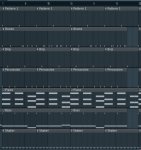Tinseltopia
New member
Okay, so I was making a beat earlier today with some recorded sounds, and the samples just fit better with a different time signature to the 4-4 I'm usually comfortable with.
So I've got a short audio sample, but I have no idea what Time Signature it is. It's 128bpm and I would love to know as researching time signatures by myself, really wasn't helpful.
For example, they say: "How many beats per bar, Count the offbeats" to determine Time Signatures - But I just end up with it being 4-4 even though it isn't because there are 6 beats per bar
https://clyp.it/zfheaui3
The beat is by no means 'Good'. I'm just experimenting with something outside of my comfort zone
So I've got a short audio sample, but I have no idea what Time Signature it is. It's 128bpm and I would love to know as researching time signatures by myself, really wasn't helpful.
For example, they say: "How many beats per bar, Count the offbeats" to determine Time Signatures - But I just end up with it being 4-4 even though it isn't because there are 6 beats per bar
https://clyp.it/zfheaui3
The beat is by no means 'Good'. I'm just experimenting with something outside of my comfort zone



